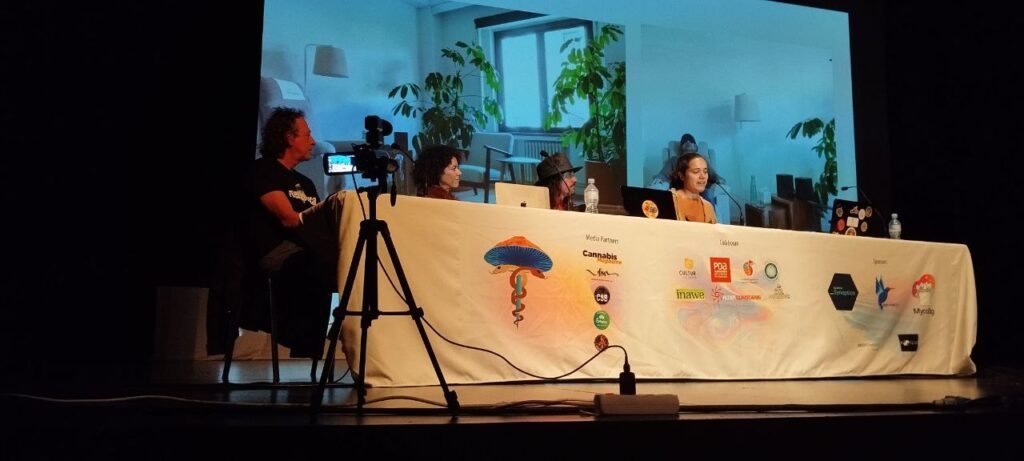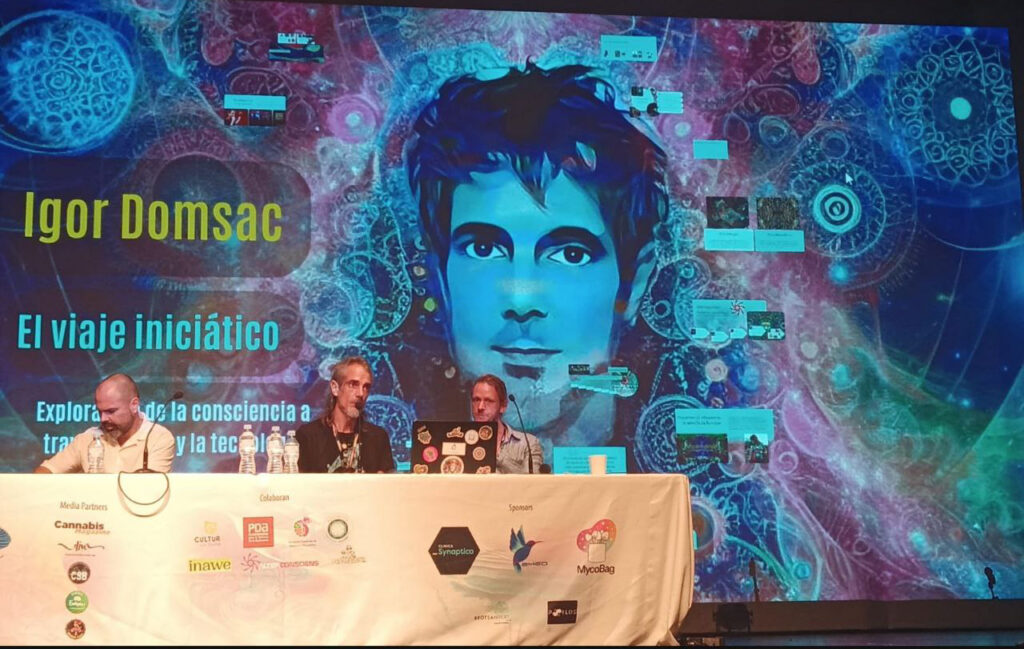Igor Domsac | November 18, 2025
Fuerteventura, with its volcanic landscape and supernatural light, became for a week a meeting point between ancestral knowledge, contemporary science, and a growing community seeking to engage with traditional Indigenous medicines and their synthetic analogues with respect and responsibility. The general atmosphere, evident in the corridors, workshops, and impromptu meetings, was unanimous: the event exceeded all expectations and left a feeling of collective cohesion that is not always easy to achieve in the current European psychedelic landscape.
For ICEERS, Fuertedélica represented a particularly significant gathering: a place where several members of the team were able to contribute from their areas of expertise—science, integration, support, communication—and where the voice of Shipibo teacher Ronin Wesna brought the depth of a living tradition. In Fuerteventura, it became clear that ICEERS helps to sustain that bridge between disciplines, communities, and generations.

Fuertedélica Week: opening the circle
The prelude to the conference—Fuertedélica Week—marked the uniqueness of this edition from the outset. More than just an appetizer, it was a space for physical, mental, and spiritual preparation where local practices and Indigenous traditions coexisted. Attendees went from conscious breathing to ice baths, from movement workshops to rituals incorporating plants endemic to the Canary Islands and elements of Amazonian iconography.
Heiko—from 7LemonsHouse in Lajares—tuned the body with breathwork sessions and ice baths, while Claudia Valdeón Liébana led a ceremonial journey with local plants that intimately connected attendees with the Canary Islands. NaKa, from El Templo, focused on voice and ritual expression, while Karina Bertolotto offered essential somatic tools for those who accompany psychedelic processes. Music played a special role thanks to Juan Calvi, who opened up spaces for sensory exploration through his entheogenic soundscapes. Ketamine-assisted psychotherapy was addressed in a practical way in a workshop facilitated by Joan Obiols, José Carlos Bouso, Irene Pérez, and Marta Martín. And mycology took on unexpected importance with an exclusive workshop for Fuertedélica, in which Isaac Vidal, Jacint Moya, and Antti Lehtonen guided participants through the entire process of mushroom cultivation: from basic theory to methods of mycelium propagation, inoculation, and live preparation of a monotub that was raffled off among the audience.
In addition, Liana Aya Silvey presented integration as an embodied regenerative process, Diego González (High Vibe Tribe) explored sound therapy as a path to health, and Marco Giglio closed the spectrum with a focus on conscious nutrition. Fuertedélica Week did not function as a simple prologue, but rather as an experiential fabric that prepared the group to access the conference with a shared sensibility.
What emerged was the feeling of entering a liminal space: neither a retreat nor an academic conference, but a bridge between seemingly unconnected worlds. Many participants described Fuertedélica Week as a process that opened the body to listening and allowed them to approach the conferences with a clearer focus, less conditioned by expectations and more open to a transformative experience.
The organization managed to maintain coherence in a diverse program, articulating the week of activities under a common thread: to offer a safe and respectful space where Indigenous practices and contemporary innovations could dialogue without friction.

The varieties of the psychedelic experience
As the conference began, a sense of community was already palpable in the air. The sessions were structured around the themes of preparation, initiation, and integration, a conceptual framework that allowed for the organization of scientific presentations, traditional practices, ethnobotany, therapeutic models, and public policy.
On Friday morning, the young researchers’ panel featured Sophia Vasconcelos (“Post-treatment support as a therapeutic extension in ketamine-assisted psychotherapy”), Óscar Soto (“Integrating phenomenology and psychotherapy in working with psychedelics”), Cécile Giovannetti (“Ayahuasca and mental health in Indigenous peoples and Latin American patients”), and Gerardo Gonzalo, who explained the relationship between theory of mind and the default neural network through psychedelics.
In the afternoon, after a musical journey led by High Vibe Tribe, José Carlos Bouso’s welcome speech established the conceptual framework that would guide the conference, followed by a wide variety of presentations. The presentation of sponsor projects showcased initiatives such as Clínica Synaptica (Marta Martín), BMed Global (Karina Bertolotto), and MycoBag (Rubén Valenzuela). This was followed by the opening lecture, “Medicine and Shipibo Culture,” by Ronin Wesna, accompanied by Iñaki Berazaluce, director of the documentary series “The Voices of Ayahuasca.” Irene Pérez (Clínica Synaptica), Marc Aixalà (ICEERS), and Rafael Guimarães dos Santos participated in the preparation table, addressing the preparations required for the administration of these medicines. Finally, the keynote speech “The Tribulations of a Psychedelic Psychiatrist” was given by Dr. Joan Obiols, president of ICEERS and one of the pioneering figures in the introduction and clinical exploration of psychedelics in the Spanish context, whose career combines decades of psychiatric practice with a vision ahead of its time regarding the therapeutic potential of these medicines.
On Saturday, the introductory panel brought together Mendel Kaelen—bridging music and neuroscience—Igor Domsac—who addressed the initiatory journey from artistic creation—and Jesús González Mariscal, who steered the conversation toward Mazatec shamans and sacred mushrooms. After this initial overview, the afternoon opened a fertile interlude dedicated to the presentation of projects: Ingrid Tartakowsky shared her book The Spiritual World of Ayahuasca, Adela Abad presented the delicate work of Proyecto Esperanza (Project Hope), and Flora Sirkia introduced PsyFlow, three perspectives that broadened the horizon of the gathering. Later, the integration phase shifted the focus to the art of returning with meaning: Kiko Castellanos (“When the Circle Speaks”) explored the narratives that emerge after the experience, while Eirini Argyri (“The Dark Side of the Psychedelic Experience”) and Liana Aya Silvey (“Psychedelic Integration, a Regenerative Process of Internal Ecology and Social Well-being”) completed a mosaic of perspectives that invited us to think of transformation as a slow, profound, and necessarily shared process.
The public policy block kicked off with the round table “Psychedelics and public policy,” where Miguel Castejón discussed global regulation, Héctor Brotons addressed legal aspects in Spain, and Aura Roig spoke about the link between feminism and drug policy from an intersectional perspective. The conferences ended with a keynote speech on “The Use of Psychoactive Plants in Indigenous Canarian Cultures,” presented by Fernando Hernández and moderated by José Gregorio González, reinforcing the cultural and territorial focus of the meeting.
Traditional Indigenous medicines took center stage. The presence of rituals, knowledge, and Indigenous perspectives was not presented as a cultural embellishment, but as a reminder that the contemporary psychedelic renaissance is rooted in deep traditions, often rendered invisible by Western voracity. For its part, the audience responded with attention and maturity, creating an atmosphere where ayahuasca, mushrooms, and Canarian practices could be discussed responsibly, rather than with the superficial fascination that sometimes dominates public conversation.

The presence of ICEERS: a compass on the path
Part of the success of the event was due to the conceptual clarity provided by the ICEERS team, whose contributions helped set a tone of rigor, ethics, and intercultural sensitivity. Dr. José Carlos Bouso, scientific director of the foundation, acted as master of ceremonies, opening the meeting, moderating several of the panels, and presenting the final conclusions.
Marc Aixalà, with his background in psychedelic integration, provided a particularly valuable perspective on the preparation for these experiences. His contributions helped to understand that working with Indigenous medicines requires careful and often prolonged accompaniment. “Throughout my years working in the integration of difficult experiences, one constant was the lack of preparation. Making poor decisions about when, where, and with whom to take it, dosages, situations—in other words, not knowing where one is going. That increased the chances of things getting complicated,” he said.
Igor Domsac took us on a journey through his creative career, marked by his attempt to translate the psychedelic experience into different artistic languages. His presentation culminated with the screening of “Psilocibes, lo percibes,” an immersive audiovisual piece developed with the help of various generative artificial intelligences. The result was a sensory journey that unfolded images, rhythms, and atmospheres evoking expanded states of consciousness, which integrated naturally into the exploratory spirit of the conference.
Finally, Kiko Castellanos stood out for his perspective on community integration and analysis of post-ceremonial discourse, opening up a field that has been little explored but is essential for understanding how people reconstruct meaning after intense experiences with master plants. His perspective naturally connected Indigenous talking circle practices with contemporary narrative frameworks.

An event that left its mark
At the end, the general feeling was that of having experienced something more than just a conference, recognizing the growing maturity of the psychedelic movement and the importance of integrating Indigenous and scientific knowledge with the creation of community ties and interpersonal care. The hallways filled with smiles, the hugs after each workshop, the conversations late into the night, and the absence of logistical conflicts testified to a particularly well-organized, appreciated, and celebrated edition.
Fuertedélica 2025 showed that when science, tradition, and community come together without hierarchies, a new territory emerges where research dialogues with Indigenous spirituality and integration becomes the thread that holds everything together. For those who have been working for years with master plants, mental health, and cultural justice, the event was a reminder that this field is advancing steadily, incorporating new voices, new practices, and new questions without losing sight of the traditions that gave rise to it.
For those who have been working for years with master plants, mental health, and cultural justice, the event was a reminder that this field is advancing steadily, incorporating new voices, new practices, and new questions without losing sight of the traditions that gave rise to it.
In this context of growth and maturity, the upcoming World Ayahuasca Forum appears as a logical step within the movement itself: a gathering conceived and organized by Indigenous leaders, where decisions and conversations come directly from those who have safeguarded these practices for generations. If Fuertedélica allowed for debates to be opened and new connections to be forged, the Forum will offer a broader and more deeply rooted framework from which to continue advancing toward more balanced forms of collaboration, where the diversity of traditions, experiences, and knowledge can coexist without hierarchies and with a shared sense of responsibility.
Categories:
EVENTS
, NEWS
Tags:
ayahuasca
, ethnobotanicals
, psychedelics
, traditional medicine
, conference
, mental health
, psychedelic integration
, ICEERS
, conferencia
, integración psicodélica
, Indigenous peoples
, Fuertedélica
, medicinas tradicionales
, pueblos indígenas

